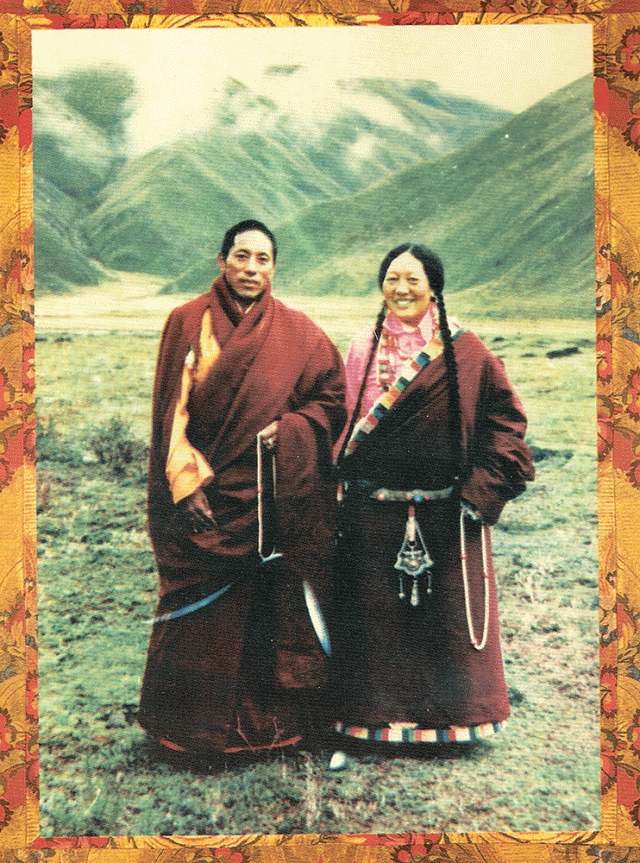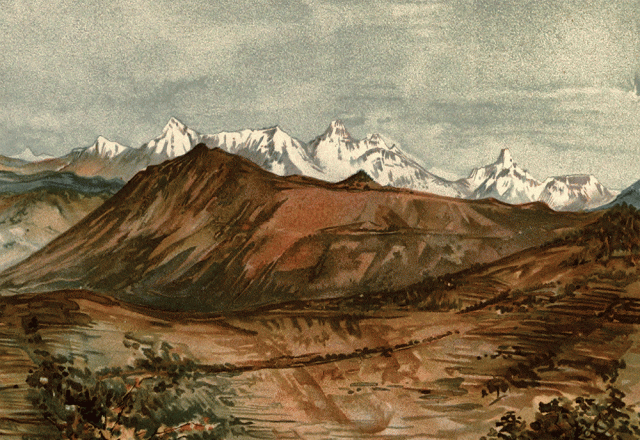
“Please bear in mind that I have great affection / For my inseparable companion across many lifetimes,” wrote Namtrul Rinpoche to the female Buddhist visionary Khandro Tare Lhamo in 1978. Later, she echoed the sentiment: “Congenial friend, I recall our connection. / Of course, I remember, darling. / I could never forget your love and affection.”
The Buddhist tantric couple Khandro Tare Lhamo and Namtrul Rinpoche exchanged love letters in the wake of the Cultural Revolution (1966–76) and the destruction of most visible signs of Tibetan culture, including the vast majority of Buddhist temples and monasteries. Through intimate exchanges and visionary recollections, they reached beyond the destruction, tracing their connection across lifetimes to the advent of Buddhism in Tibet. This allowed them to access a wellspring of teachings and blessings with which to begin again.
Via secret messenger, they exchanged 56 letters between 1978 and 1980 in which they envisioned their prophetic mission to restore Buddhism to eastern Tibet and developed a lasting personal bond. In the letters, their joy and affection in recalling their past lives together is matched only by the sadness of their separation across province borders at a time when travel was highly restricted. Indeed, during this period the couple met only once, when Namtrul Rinpoche surreptitiously traveled from Serta in Sichuan Province to Padma in Qinghai Province to spend a brief sojourn with Tare Lhamo and meet her relatives.
Related: Spirit in Exile: Tibetan Nuns
Khandro Tare Lhamo (1938–2002) was the daughter of a prominent teacher in Golok, a region of eastern Tibet, and received esoteric training with the acclaimed tantric masters of her day. Tragedy struck during the socialist transformation of Tibetan areas in the late 1950s, and her first husband and three brothers, all reincarnate lamas, were imprisoned as “class enemies” and died shortly thereafter. Only a teenager at the time, Namtrul Rinpoche (1944–2011) was spared their fate, even though he had been enthroned as a reincarnate lama in his youth. Tare Lhamo spent her twenties and thirties consigned to manual labor, and Namtrul Rinpoche served as the secretary for his work unit with the literary skills he had developed during his monastic education.
Given this historical backdrop, their exchange has a remarkably upbeat tone. In her second letter, Tare Lhamo, who initiated the correspondence, issued a galvanizing call to action, suggesting that a show of strength—represented by two mythic animals: a snow lion emitting its valiant roar and a garuda spreading its sturdy wings—was needed to once again “spread the teachings far and wide.” The two envisioned healing the damage of the Maoist period by revealing terma—or treasure teachings traced to the 8th-century Indian master Padmasambhava, who is credited with a major role in establishing Buddhism in Tibet. As reincarnations of Yeshe Tsogyal and Namkhai Nyingpo, among the 25 main disciples of Padmasambhava, they had the distinctive pedigree to undertake such healing.
Written almost entirely in verse, the correspondence unfolds from there in an intriguing mix of prophecy, ornate poetry, and folk songs. In my translations below, I offer examples of folk styles to give the reader a sense of the playful quality of the courtship between Namtrul Rinpoche and Tare Lhamo, and how the couple asserted their unique compatibility by invoking the karmic forces joining them, including their aspirations and vows in previous lives and the command of Padmasambhava, whom they referred to as Orgyan Padma. Images of fertility and regeneration are peppered throughout, alluding to their future revelatory and restorative efforts. Still, the intimacy is palpable in their requests to each other to speak frankly—“whatever comes to mind, no secrets!”—and in their use of terms of endearment and nicknames. Her nickname is Tarpo from Tare, and his is Tsebo from Tsedzin, his childhood name (his formal name was then Drime Lodrö). Where the selection of letters below leaves off, Namtrul Rinpoche set out to visit Tare Lhamo; after that, their resolve to spend their lives together intensified.
Finally, in 1980, Tare Lhamo left her homeland to join Namtrul Rinpoche in Serta, where they rebuilt Nyenlung Monastery as their main seat. During the 1980s and ’90s, the couple traveled and taught side by side throughout eastern Tibet. Together they conducted large-scale rituals for monastics and the laity, provided financial support to at least ten other monasteries, and built stupas and temples to re-sanctify the landscape, thus making a significant contribution to the restoration of Buddhist teachings, practices, and institutions during the post-Mao era.
Related: Tibet: Fifty Years of Exile
Namtrul Rinpoche relayed to me that after Tare Lhamo passed away in 2002, she remained at his side. His lament on the anniversary of her passing serves as a final letter and postscript to the correspondence. In response to his cries of sorrow, as recorded, Tare Lhamo appeared in the sky, surrounded by dakinis (female tantric deities), to console him and recall their inseparability across lifetimes: “Even when separated in the manner of relative appearances, / In the definitive truth, fundamentally, we’ve never been separated. / From your indestructible, original mind beyond measure, / I didn’t go anywhere. There is nowhere else for me to go.”
–Holly Gayley
TARE LHAMO
LETTER 2
Aho! Mirror of my heart,
Open your ears and listen to this.
Ala! Dear friend, I sing a song of marvels:
On stalks of bodhi, the root of mind,
If the crops of virtue are not ripe,
It’s difficult for Tibetans to be happy.
If the snow lion doesn’t emit its valiant roar,
It’s difficult to subdue the lowland beasts,
Now’s the time to unfurl its mighty turquoise mane.
If the young garuda won’t spread its sturdy wings,
It’s difficult for us birds to reach the heavens
In a flight path so far across the lofty sky.
Ala, how wondrous! Long life!
May the teachings spread far and wide.
NAMTRUL RINPOCHE
LETTER 6
Loving and affectionate one, radiance of my heart,
Our connection from previous lives dawns in mind.
Happy and sad, tears fall as a steady stream of rain.
In the turquoise valley of an unwavering mind,
The lotus of faith and stainless samaya blooms,
Unharmed by obstructing conditions like frost,
This is the honey nectar of profound secret mantra.
The display of disciples as a full retinue
Is the wish of the unequaled father guru,
The aspiration of protector Orgyan Padma,
The oath of warriors and mother dakinis.
These are scribbles, whatever arose in mind,
By the slightly impetuous madman priest, Tse.
Incomparable friend Tarpo, steady in intent,
Please speak frankly, whatever comes to mind, no secrets!
TARE LHAMO
LETTER 7
One hundred times a day,
I recall the spiritual support;
My congenial friend comes to mind.
The sketch of past lives becomes clearer;
Mind yearning, my fondness increases.
“Separation” is like the heart being ripped out.
Ah! It is just so. But there’s no need to be sad.
Hold in your heart the oath of the mother dakinis.
We must respect Lord Padma’s command.
May the sublime Three Jewels and protectors bless the
congenial friend so that our wishes may be fulfilled.
NAMTRUL RINPOCHE
LETTER 9
Shall I also sing a song?
Dharma valley, oh, the auspicious jewel land,
Happy flowers, oh, in a lotus grove of delight,
Quivering hum, oh, it belongs to the little bee.
Melodious song, oh, recurring strum of the lute.
Sweet dew, oh, enjoy the extract of honey,
Yes, little bee, a bu lo lo wo!
Quivering hum, oh, through this sweet melody,
I refresh the memory of my affectionate friend.
I cannot help, oh, but hum a tune!
Singing this song, it reaches the snowy peak.
Snowy peak, oh, how could it possibly tremble?
Sweetheart, my mind is more firm than that.
Singing this song, it reaches the depths of the lake.
Verdant lake, oh, how could one possibly judge its depth?
Sweetheart, my devotion is more deep than that.
In past lives, deeds and aspirations were good.
At present, the shared coincidence is good.
Later, come! Oh, the final aim is good.
The three goods, oh, aspirations and wishes fulfilled.
Friend, I am caught on the iron hook of your
loving affection.
My three gates, oh, I delight to see you amid the crowd.
First and foremost, the inner and outer elements,
Second, the power of prior vows and aspirations.
Because of my faith and yearning fondness,
How could I dare to be apart from you, friend?
Do I cherish the eyes on my face that let me see?
You, dear friend, I cherish more than that.
Do I cherish the heart that upholds the mind?
You, dear friend, I cherish more than that.
When wildflowers bloom across grassland meadows,
The beautiful form of my beloved comes to mind.
When the cuckoo bird emits a melodious call,
The musical speech of my beloved comes to mind.
When sunrays shine at the break of morning’s dawn,
The affectionate mind of my beloved comes to mind.
Splendor of high peaks, though I’ve seen
hundreds, thousands,
You are the queen of the snowy range, none higher.
At this juncture, due to the oaths of the past,
I promise to honor you always and forever.
I feel shy to say any more than that. That’s the point, darling, nothing else.
Though fatigued, the distance is not far. Whatever the means, it’s certain we will meet.
Only friend, whose mind is stable as the snow mountain,
Please remain within the radiant bliss of my heart.

TARE LHAMO
LETTER 14
E ma! Supreme companion, radiance of my heart,
As I utter this song, sorrowful in mood,
Friend, you’re an incomparable spiritual support.
Even if we haven’t been separated for an instant,
Within my miserable life in the snow mountains,
Not even one day has passed without sorrow.
Just so is the manner of sadness with me.
Jewel palace in the deep blue heavens,
The golden sun spontaneously shines forth,
The turquoise dragon meets its retinue there.
Cluster of stars circled by hundreds of thousands.
May seasonal rains continue to pour down without end.
Just so is the destiny of two eminent selves.
Between, in the happy sphere of this human world,
Sublime lamas remain for the benefit of beings;
Naturally we meet in the practice of creation
and completion.
Surrounded by hundreds of thousands of the populace,
May dharma teachings and all knowledge flourish;
The benefit to beings of us two friends is like this.
Offering this song, both happy and sad,
Signs of coincidence arise as a result.
Friend, may we happily meet soon
To accomplish great benefit for the teachings and beings.
Of course, we will spend our life together,
Dear friend, affectionate radiance on my heart.
Recalling you a thousand times a day, what need I say.
In bed at night, it’s not possible to fall asleep.
Is there a way for you to come? Think it over!
When a good time comes, whichever day or month,
I’m happy.
Your tender affection is unforgettable.
Just so I remember the promise of my companion.
These are steadfast words, changeless and firm.
Spiritual support, never separate for even an instant,
Dear Tsebo, unforgettable and close to my heart,
Please remain within the radiance of bliss.
NAMTRUL RINPOCHE
LETTER 13
Beloved, vine of my mind, great affectionate companion,
I offer auspicious words and good tidings at setting forth.
Stay well, invincible turquoise lake of wealth!
Gold-eyed fish with six fins, setting out across,
Flaunts its skills in the middle of the vast lake.
Without delay, fish and lake shall happily meet.
Stay well, Indic fortress of sandalwood forest!
Powerful tigress, setting out for the meadows,
Flashes its six stripes on a grassy hilltop overlook,
Without delay, tiger and forest shall happily meet.
Stay well, pristine snow mountain!
Splendid snow lion, setting out for the craggy peaks,
Unfurls its turquoise mane atop a dark boulder.
Without delay, snow lion and white peaks shall
happily meet.
Stay well, dearest friend, jewel of my heart!
Lowly me, Drime Lodrö, setting out for your homeland,
With good intention to benefit the teachings and beings,
Without delay, you, friend, and I shall happily meet.
♦
Translations by Holly Gayley from the 2003-4 publication of the letters of Khandro Tare Lhamo, Garland of Lotuses, and those of Namtrul Rinpoche, Adamantine Garland.
Thank you for subscribing to Tricycle! As a nonprofit, we depend on readers like you to keep Buddhist teachings and practices widely available.
